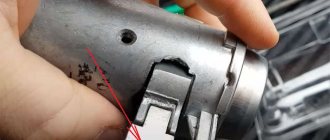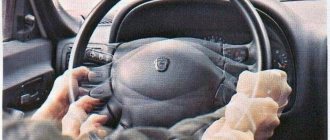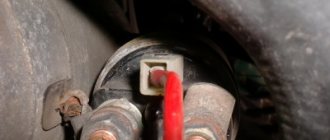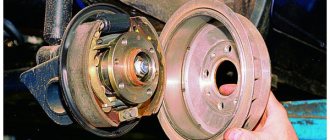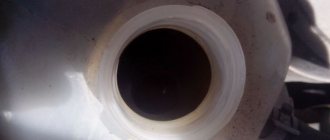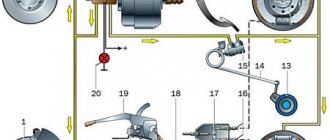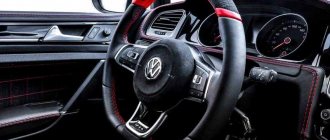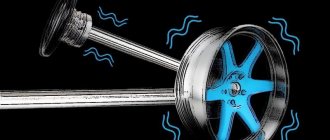To understand why the steering wheel turns tightly, you need to find out what type of steering is installed on your car - a regular one with a steering rack, in addition to a hydraulic booster (power steering) and an electric power steering (EUR), combined (EGUR), with a pre-amplifier. Let's look at the first four cases, which are the most common.
First, we will dwell on the general causes of a tight steering wheel, then we will distribute them by type of steering, focusing in more detail on the VAZ 2105, 2106 (and other models from this line), 2109, Chevrolet Lacetti, BMW e39, Mazda 3, Volvo xc90, Renault Symbol and Gazelle.
But it is important to understand that the force on the steering wheel is checked only in motion or with the front wheels hanging. If the car is stationary, large loads occur on the steering elements. This is especially dangerous for rear-wheel drive cars, for example, VAZ classic, where the steering column is attached to a spar, which can crack under heavy loads.
Common reasons
There are reasons that do not depend on the type and condition of the steering elements, these include low tire pressure and incorrect wheel alignment, violation of body geometry, etc.
In the first case, due to the large contact patch between the tire and the road, not only tire wear increases, but also the load on the steering wheel increases, which begins to turn tightly. In the second case, incorrect wheel angles also lead to this malfunction. We'll talk about the influence of body geometry later.
You should also pay attention to the steering knuckle bearing, shown below in the Nissan Primera example. Due to the wear of the boot, it rusts, as a result you have to make more effort when turning.
And yet, it is important to understand that if other tires were installed on the car and they are larger and wider than the previous ones, then the steering wheel will be difficult to turn and this is natural, there is no need to panic.
It is also worth paying attention to the crosspieces (universal joints) of the steering column. There may be one or two of them (lower and upper), it all depends on the design. The crosspieces may bite or after installing new ones, the steering wheel will be difficult to rotate for some time.
Be sure to pay attention to the cardan boot, for example, on the Toyota Caldina 2.0 MT 4WD FULL it looks like this.
If it is torn, then replace it, since over time, water and dirt that gets there will lead to bad consequences. The first sign that the problem is in the crosspieces is a tight rotation of the steering wheel with cyclic jerks.
Also, different behavior of the steering wheel is possible as a result of linear expansion of the parts. As a rule, if the tolerances and fits in the parts are selected correctly, and this also applies to the crosspieces, then after they are heated or cooled, no jamming occurs, and the steering wheel turns easily and smoothly.
If these parameters are not maintained correctly, and this no longer applies to original spare parts, then the steering wheel will be difficult to turn, with jamming both when the engine is cold and when it is warm.
Wheel balancing is out of balance
Many people doubt whether wheel balancing is necessary in principle. It is necessary, since it is responsible for the uniform distribution of the mass of the wheel relative to its center. Its uneven distribution leads to rapid wear of tires, wheels and suspension, and also causes strong body vibration, which is clearly felt in the cabin. If the steering wheel shakes in your hands, then turning it and simply holding it in place will be extremely difficult. Therefore, if strong vibration occurs, it is worth balancing the wheels.
If you have electric power steering
If the steering wheel has become difficult to turn, then with a 99 percent probability repairs cannot be avoided. The most common problems with electric power steering involve a blown fuse or the motor burning out due to contact with moisture. A little less often, the problem lies in the failure of the steering wheel rotation sensor, and, of course, banal wear of parts should not be dismissed. In any case, to find out exactly and carry out repairs, you will need the help of a professional auto electrician.
If you have power steering
It, as already noted, has a more complex design, so in order to identify the cause of the malfunction, you will have to work hard.
Power steering
Most modern cars, for example, Chevrolet Lacetti, Volvo xc90, BMW e39 (not on all models), Renault Simbol, Gazelle GAZ-3302 (not on all models, the latter have an ESD) have been and continue to be installed with power steering. It is malfunctions in its operation that can lead to the fact that you will have to make a lot of effort to drive the car.
Oil level and condition
The first thing you should pay attention to if the steering wheel starts to turn tightly is the presence and condition of oil in the power steering reservoir. Its low level is the most likely cause of the problem. But you need to take into account that the level of heated liquid may differ from cold one.
It is important to find out why this happened:
- natural consumption (you just haven’t looked into the tank for a long time);
- leakage occurred as a result of wear or damage to sealing elements, hoses, etc.
If the oil level in the tank is minimal, then it is better to refuse further operation of the car in this situation, as this may lead to pump failure. As a last resort, you can remove the power steering drive belt and thus try to get there or call a tow truck.
Also pay attention to the condition of the oil, ask yourself - “When did you change it and what kind did you fill in?” There have been cases when simply replacing it solved the problem. But here it is important to fill in the oil prescribed in the operating manual for your particular car model, and not experiment.
Air in the system
Air can get into the booster hydraulic system for various reasons, the main one being improper replacement of the working fluid (oil).
It is clear that the presence of air bubbles in the system will negatively affect the transmission of forces as a result of a decrease in pressure, which will lead to tight rotation of the steering wheel.
To solve this problem, it will be sufficient to turn the steering wheel completely to the right and left several times with the engine running. This will renew all the oil in the expansion tank and squeeze out the air.
Power steering belt tension
Check the condition of the power steering drive belt. If it slips, which is often accompanied by a whistling sound, the pump will not create the required pressure in the system. For this reason, the steering wheel will turn tighter.
An overtightened belt will create an unnecessary load on the drive shaft and, accordingly, on the engine, thereby causing rapid wear of the bearing, reducing the efficiency of the pump and motor.
If the belt is tensioned correctly, but wears out noticeably quickly, then remove it from the pulley and turn it last. It should rotate freely without grinding or jamming. Otherwise, you will have to change the bearing.
The schematic diagram of tensioning the UAZ Patriot power steering belt is shown below.
Thick oil
In winter, if the steering wheel starts to turn hard, pay attention to the condition of the oil in the tank. If it has thickened greatly, it means it is not suitable for the given operating conditions.
Make sure that the fluid has been filled according to the car manufacturer's recommendations. If necessary, replace with another after consulting with specialists.
Anti-leak in power steering
Temporary restoration of the operation of the hydraulic booster is possible with the help of special sealants, which, due to their properties and the additives they contain, improve the operation of the power steering and eliminate leaks in the system.
But there is also the other side of the coin. Improper use or the use of counterfeit products leads to changes in the viscosity and other performance properties of the oil and, as a result, it may become thicker and you will have to make more effort to drive the car.
The problem is solved by replacing the oil and the reasons for its leakage, followed by eliminating the use of sealants.
Power steering filter clogged
Find out whether the power steering of your car model includes an oil filter, which is usually located in the tank. The first sign that it is clogged is when it becomes difficult to turn the steering wheel when the engine is not yet warmed up.
This happens because the still cold and viscous oil has a hard time passing through the filter. In the future, the problem disappears, since it is already heated and becomes more fluid.
Pressure regulating valve
The valve may stop working for many reasons, from simple blockage to piston misalignment as a result of mechanical stress on its body, for example, when replacing a pump.
If the pressure in the system has dropped, it is worth checking the condition of this valve.
Soon the end of the pump
Low pressure in the system with a normal oil level, correct drive belt tension, no kinks in the hoses, or a intact valve may indicate that the power steering pump is running at its limit as a result of wear of its parts. The problem can only be solved by repairing or replacing it.
Loss of engine power when turning
There are situations when the steering wheel starts to turn tightly only when turning, but when driving straight this problem does not arise. At the same time, the engine power “sags” when turning.
It's all about the steering rack. This topic is fully covered in the section about the VAZ 2109.
In some car models, tight rotation of the steering wheel is caused by other specific causes, for example, on the Volvo xc90 the problem can arise due to wear of the ring notches of the FO 044VALVE pressure reducing valve and the ellipse along which the rotor blades slide. Replacing the valve can save the situation without replacing the entire pump.
But the whole difficulty here is that the power steering will have to be removed. For ease of work, you will need a wrench with Torex 50.
Fluid replacement and selection rules
To solve this problem, you do not need to completely disassemble the mechanism.
- The expansion tank is connected to two pipes. They should not have clamps after preparation.
- Additional fasteners and belt elements are also removed if necessary.
- You can simply drain the used fluid and then add new one.
But it is advisable to dismantle the steering wheel itself in order to carry out as complete a diagnosis as possible. The device must be checked separately to ensure that it remains sealed. It is best to wash the insides and rinse them with plain water. When the expansion tank is dry, it is returned to its place.
We must approach the issue of choosing a suitable liquid no less responsible. The optimal solution is synthetic hydraulic mixtures. Photo: drive2.ru
The main thing is that only high quality components are used in production. Conventional engine oils are strictly prohibited in such situations.
Among the features inherent in specialized formulations:
- Ability to operate in extreme temperatures.
- Viscosity.
- Fluidity.
Problems of this kind often arise in winter. After all, freezing simply does not allow the liquid to cope with its main functions.
This video will also help you solve the problem of replacing power steering fluid:
Steering rack
It is an integral part of the car's steering. It is to facilitate the movement of its elements, as well as steering rods, that power steering, electric power steering and other types of amplifiers were developed. The latter may or may not be installed on the machine.
In the latter case, the car is controlled only due to the driver’s physical impact on the steering wheel with the subsequent conversion of the rotational moment into the translational movement of the steering rods.
This transformation is carried out due to the gear rack, precisely because of the constriction of which it becomes difficult to turn the steering wheel.
The problem is easily solved by loosening the adjusting bolt, which is present on almost all steering racks or steering gears, such as, for example, in the VAZ 2105.
Let's look at specific examples.
VAZ 2105, 2106, 2107
The first thing you need to look at when on a VAZ 2105, 2106, 2107 and other cars from this model range, the steering wheel begins to turn tightly, especially with the front wheels hanging, is the steering gearbox (column).
By external inspection, make sure that there is no oil leakage through the seals in the unit. Check the transmission oil level in the gearbox through the filler (control) plug. Make sure the steering column is adjusted correctly and is not pinched.
The second thing to do is check the condition of the ball joints. There are four of them, two on each side, top and bottom. If they are worn out and there is play in them, then this can also affect the increase in effort to rotate the steering wheel.
Next, check to see if one or both ball joints are jammed. To do this, disconnect the steering tips from the column. This is done so that the steering knuckle can be rotated freely.
If it rotates heavily with a knocking noise, the ball joints are jammed and will have to be replaced.
Next, check the left and right pendulum arms for wedging; to do this, disconnect the steering rods from them and move them by hand. They should walk freely, without grinding. Otherwise, replace them. For example, they can jam due to misalignment of the nylon bushings.
It’s better to immediately replace the pendulums on bushings with an analogue with ball bearings. You will immediately feel how easier the steering wheel begins to turn.
Also check the tie rod ends for play. If new tips were installed, then it will be difficult to drive the car for some time until they develop and become easy to move.
Angle of inclination of the stand (caster).
It would seem that this has something to do with the caster and the tight steering wheel. As a rule, the angle of the strut (positive or negative) is set by the manufacturer, and it does not change during wheel alignment.
But there are situations when on VAZ classics 2101 - 2107 at the service this indicator is changed, for example, from 0 (factory) to 1. This leads to the fact that the steering wheel begins to rotate harder, but at the same time it returns to the zero position faster after completion turn.
If you drive around the city more, then cluster 0 is more preferable, since the steering wheel rotates easier with it, but it does not return to its original position as quickly.
With cluster 1, the opposite happens: the steering wheel turns hard, but returns quickly. This cluster is preferred by drivers who travel more outside the city.
Body geometry.
Few people know about this, but on old VAZ classics it is possible to change the body geometry. For this reason, the casters are disrupted and the steering wheel begins to turn tightly.
To solve this problem, find two washers 4 mm thick and place them in the lower arms on both sides, but only in those places that are on the driver and passenger sides, and not on the radiator side.
Thanks to this, the lever will be located at an angle in relation to the beam. Next, do the wheel alignment, the steering wheel should turn easier.
VAZ 2109 and other models
The steering rack is installed here. As a result of wear of its internal parts and an increase in the gap between them, over time it begins to knock. This also applies to other cars with the same type of steering, VAZ 2110, 2114, 2115, Lada Priora, Kalina, Granta, etc. The last three models already come with an electric power steering system.
Using a special adjusting bolt, the gap between the drive gear and the rack is reduced and the knocking stops.
But if you tighten the bolt, a situation will arise when the steering wheel turns tightly. Therefore, it is important not to overdo it here.
And further. It is important to understand that the rack itself wears out the most in its central part (moving straight). There is less wear on the edges (when turning). Therefore, when adjusting, the central part of the rack is pressed normally, but the edges are pinched. As a result, if the car is moving straight, the steering wheel turns normally, but when turning it is tight.
For the same reason, if the car has power steering, the load on the pump increases when turning. It is transmitted through the pulley and belt to the engine, which “sags,” i.e. loses power.
The way out of the situation is to loosen the bolt a little or replace the rail.
Other reasons:
- Worn bearings on the upper shaft of the steering column;
- Seized strut support or bearing;
- There is no lubrication in the steering rack.
What are the signs that indicate a problem?
The feeling of heaviness when steering the steering wheel does not always appear suddenly and at once. This can be a long process, during which warning signs may arise. In particular, initial diagnostics will help detect problems due to the formation of leaks, noise and excessive vibrations. Over time, a tight steering wheel will be added to this list if the same leak is not stopped and the fluid supply is replenished. Of course, the above signs may also indicate the appearance of other problems, and not only with the hydraulic booster. Therefore, general diagnostics in this case will not be superfluous. It will also allow you to more accurately determine the possible cause of the weighting of the steering wheel.
Electric power steering (EGUR)
According to the principle of operation, electric power steering is not much different from conventional power steering. The main difference is that here the power steering pump is driven not by the internal combustion engine, but by an electric motor. The system also includes an electronic control unit.
The pump itself (geared motor) can be of two types: vane and gear. The second type is considered more reliable.
EPS is installed on many foreign cars, for example, Ford Focus 2, Skoda Fabia, Mazda 3. And also on some domestic cars, for example, Lada X-Ray.
Let's look at the reasons why the steering wheel turns tightly, using the Mazda 3 as an example:
- Deformation of the steering rack. The problem is solved only by replacing the latter;
- Low voltage in the on-board network. The battery is dead, the generator is malfunctioning.
- Incorrect steering wheel calibration or the ECU does not see its position at all. The previous and this problem can be easily diagnosed in the service.
- The relay has failed. On Mazda 3 it is located under the hood in the fuse box. But perhaps the relay has not failed, but the contacts under the block itself have rotted - this is a Mazda 3 disease.
- The power steering fuse has failed or the power supply circuit to the electric motor has broken.
Sometimes, in order to find an open circuit, you have to remove the entire pump. The problem is diagnosed at the service. - The steering rack is installed incorrectly after repair or replacement.
- Other causes related to power steering.
How does power steering work?
The hydraulic booster system is multi-component, but closed. This device is partly responsible for the difficulty of repairing the structure. A typical mechanism includes a pump, a reservoir with liquid in the form of a tank, a pressure regulator, a power unit and a spool. The pump is connected to the drive system of the machine’s engine, and the pressure regulator ensures that the force flow is balanced relative to the spool. The operating pressure difference depends on the supply of control fluid.
It is this part of the functionality that in most cases leads to problems that require power steering repair in the form of correcting the position of individual parts of the structure or by updating the oil. In turn, the hydraulic cylinder interacts with the steering rack, transmitting additional force. In order for the final load required to activate the steering wheel to be balanced, the spool itself is installed on the column - in the future it will react to the torque when the driver performs manipulations.
Electric power steering
Compared to power steering and electric power steering, the EUR is structurally simpler and therefore more reliable. It consists of an electric motor that is mounted directly on the steering column, a set of sensors and an ECU.
EUR is installed on most modern cars. Let's include domestic models - Lada Priora, Granta, Kalina, Niva (since 2009), the latest Gazelle models (GAZ 3302, 2705, 3221, 33023).
If the steering wheel on a car with electric power steering starts to turn tightly, check:
- Is the EUR indicator on the instrument panel lit? When the ignition is turned on, the lamp should light up and go out after the engine starts.
- Whether the speed sensor and speedometer work, they work synchronously with the power steering and are interconnected. The higher the speed, the less force is transmitted to the steering rack and vice versa;
- Is the torque sensor faulty?
- What is the voltage in the on-board network;
- The contacts of the 50 A power steering fuse have burned out or burned out. For example, on a Lada Priora it is located under the hood, shown in the diagram below.
If the problem persists, check the condition of the steering rack, support bearings, cardans, etc. All this has already been described above.
If your car's steering wheel starts to turn hard and you can't find the reason, ask questions in the comments, we will try to answer.
